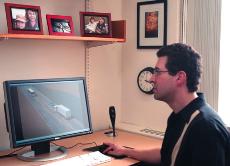UI study finds bias in videos

Professor Neal Roese, of the psychology department, examines a car crash recreation for his study on the influence of these graphics on jury members in accident cases. Suzanne Stelmasek
April 24, 2006
A recent University study shows that tools used to “clarify” car accidents for jurors may actually be more biased than informative.
The study, performed at psychology professor Neal Roese’s lab, showed that computer animation videos showing car accidents can more than double a dangerous “hindsight bias.”
Plaintiffs most often make the animations of accidents, Roese said. The videos try to show negligence on part of the defendant.
“Hindsight bias is basically the knew-it-all-along effect,” said Amy Summerville, a psychology graduate student and paper co-author. “If you already know the outcome of an event you will consider the known outcome more likely than other possible outcomes.”
Subjects, in a very basic hindsight bias study are split into two groups, Summerville said. One group is told the outcome of an event and then asked to ignore their knowledge of the event’s conclusion. They are then asked to predict the probability of that outcome among others. Another group is not told the end outcome, but asked to predict how likely they think it is to occur.
Get The Daily Illini in your inbox!
Those who “knew-it-all-along,” even though asked to disregard their prior knowledge, still rate the outcome they know is going to happen as more likely than the group that is uninformed.
This is dangerous in a court setting because juries base the damages awarded on how preventable an accident was, Roese said. If a jury thinks that the accident was more likely to happen, it will affect their decision on negligence.
The hindsight bias is something everyone has and uses in everyday life, said Florian Fessel, a psychology graduate student and study co-author. However, the way facts are presented can alter how powerful its effects are.
In the study there were four groups that considered the outcomes for two accidents, 117 University students were divided between the groups.
Two groups were shown diagrams and given written explanations of the two accidents. The two remaining groups were shown the two computer animated videos of the accident.
The videos were supplied from actual court cases and the lab consulted an engineer who specializes in making computer models of accidents.
One of each of the two groups either saw, or read about the end result in the accidents, which was a serious crash in both cases. The other two groups did not know what happened in the end, only the events leading up to the accident.
After hearing the evidence the groups were asked to give a percentage probability of each of three outcomes. Either there was no accident, a minor accident, or a severe accident.
Those who read or saw in the video what happened were asked to ignore the fact that they already knew the outcome and predict as if they were unaware of what happened.
However, even with instruction, both groups that knew the end result predicted a severe crash as more likely than those that did not know the accidents’ outcome.
The hindsight bias was also more than twice as strong for the group that saw the full video than the group that got the whole written description, Fessel said.
“Although I hope our research has outside consequences on how animations are used in courtrooms, we plan further study before making suggestions on how they should be used,” Roese said.






